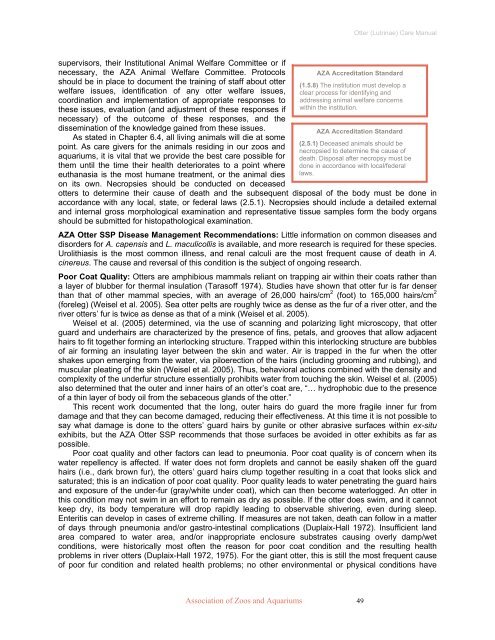Otter (Lutrinae) Care Manual - Association of Zoos and Aquariums
Otter (Lutrinae) Care Manual - Association of Zoos and Aquariums
Otter (Lutrinae) Care Manual - Association of Zoos and Aquariums
Create successful ePaper yourself
Turn your PDF publications into a flip-book with our unique Google optimized e-Paper software.
supervisors, their Institutional Animal Welfare Committee or if<br />
necessary, the AZA Animal Welfare Committee. Protocols<br />
should be in place to document the training <strong>of</strong> staff about otter<br />
welfare issues, identification <strong>of</strong> any otter welfare issues,<br />
coordination <strong>and</strong> implementation <strong>of</strong> appropriate responses to<br />
these issues, evaluation (<strong>and</strong> adjustment <strong>of</strong> these responses if<br />
necessary) <strong>of</strong> the outcome <strong>of</strong> these responses, <strong>and</strong> the<br />
dissemination <strong>of</strong> the knowledge gained from these issues.<br />
As stated in Chapter 6.4, all living animals will die at some<br />
point. As care givers for the animals residing in our zoos <strong>and</strong><br />
aquariums, it is vital that we provide the best care possible for<br />
them until the time their health deteriorates to a point where<br />
euthanasia is the most humane treatment, or the animal dies<br />
on its own. Necropsies should be conducted on deceased<br />
<strong>Association</strong> <strong>of</strong> <strong>Zoos</strong> <strong>and</strong> <strong>Aquariums</strong> 49<br />
<strong>Otter</strong> (<strong>Lutrinae</strong>) <strong>Care</strong> <strong>Manual</strong><br />
AZA Accreditation St<strong>and</strong>ard<br />
(1.5.8) The institution must develop a<br />
clear process for identifying <strong>and</strong><br />
addressing animal welfare concerns<br />
within the institution.<br />
AZA Accreditation St<strong>and</strong>ard<br />
(2.5.1) Deceased animals should be<br />
necropsied to determine the cause <strong>of</strong><br />
death. Disposal after necropsy must be<br />
done in accordance with local/federal<br />
laws.<br />
otters to determine their cause <strong>of</strong> death <strong>and</strong> the subsequent disposal <strong>of</strong> the body must be done in<br />
accordance with any local, state, or federal laws (2.5.1). Necropsies should include a detailed external<br />
<strong>and</strong> internal gross morphological examination <strong>and</strong> representative tissue samples form the body organs<br />
should be submitted for histopathological examination.<br />
AZA <strong>Otter</strong> SSP Disease Management Recommendations: Little information on common diseases <strong>and</strong><br />
disorders for A. capensis <strong>and</strong> L. maculicollis is available, <strong>and</strong> more research is required for these species.<br />
Urolithiasis is the most common illness, <strong>and</strong> renal calculi are the most frequent cause <strong>of</strong> death in A.<br />
cinereus. The cause <strong>and</strong> reversal <strong>of</strong> this condition is the subject <strong>of</strong> ongoing research.<br />
Poor Coat Quality: <strong>Otter</strong>s are amphibious mammals reliant on trapping air within their coats rather than<br />
a layer <strong>of</strong> blubber for thermal insulation (Taras<strong>of</strong>f 1974). Studies have shown that otter fur is far denser<br />
than that <strong>of</strong> other mammal species, with an average <strong>of</strong> 26,000 hairs/cm 2 (foot) to 165,000 hairs/cm 2<br />
(foreleg) (Weisel et al. 2005). Sea otter pelts are roughly twice as dense as the fur <strong>of</strong> a river otter, <strong>and</strong> the<br />
river otters’ fur is twice as dense as that <strong>of</strong> a mink (Weisel et al. 2005).<br />
Weisel et al. (2005) determined, via the use <strong>of</strong> scanning <strong>and</strong> polarizing light microscopy, that otter<br />
guard <strong>and</strong> underhairs are characterized by the presence <strong>of</strong> fins, petals, <strong>and</strong> grooves that allow adjacent<br />
hairs to fit together forming an interlocking structure. Trapped within this interlocking structure are bubbles<br />
<strong>of</strong> air forming an insulating layer between the skin <strong>and</strong> water. Air is trapped in the fur when the otter<br />
shakes upon emerging from the water, via piloerection <strong>of</strong> the hairs (including grooming <strong>and</strong> rubbing), <strong>and</strong><br />
muscular pleating <strong>of</strong> the skin (Weisel et al. 2005). Thus, behavioral actions combined with the density <strong>and</strong><br />
complexity <strong>of</strong> the underfur structure essentially prohibits water from touching the skin. Weisel et al. (2005)<br />
also determined that the outer <strong>and</strong> inner hairs <strong>of</strong> an otter’s coat are, “… hydrophobic due to the presence<br />
<strong>of</strong> a thin layer <strong>of</strong> body oil from the sebaceous gl<strong>and</strong>s <strong>of</strong> the otter.”<br />
This recent work documented that the long, outer hairs do guard the more fragile inner fur from<br />
damage <strong>and</strong> that they can become damaged, reducing their effectiveness. At this time it is not possible to<br />
say what damage is done to the otters’ guard hairs by gunite or other abrasive surfaces within ex-situ<br />
exhibits, but the AZA <strong>Otter</strong> SSP recommends that those surfaces be avoided in otter exhibits as far as<br />
possible.<br />
Poor coat quality <strong>and</strong> other factors can lead to pneumonia. Poor coat quality is <strong>of</strong> concern when its<br />
water repellency is affected. If water does not form droplets <strong>and</strong> cannot be easily shaken <strong>of</strong>f the guard<br />
hairs (i.e., dark brown fur), the otters’ guard hairs clump together resulting in a coat that looks slick <strong>and</strong><br />
saturated; this is an indication <strong>of</strong> poor coat quality. Poor quality leads to water penetrating the guard hairs<br />
<strong>and</strong> exposure <strong>of</strong> the under-fur (gray/white under coat), which can then become waterlogged. An otter in<br />
this condition may not swim in an effort to remain as dry as possible. If the otter does swim, <strong>and</strong> it cannot<br />
keep dry, its body temperature will drop rapidly leading to observable shivering, even during sleep.<br />
Enteritis can develop in cases <strong>of</strong> extreme chilling. If measures are not taken, death can follow in a matter<br />
<strong>of</strong> days through pneumonia <strong>and</strong>/or gastro-intestinal complications (Duplaix-Hall 1972). Insufficient l<strong>and</strong><br />
area compared to water area, <strong>and</strong>/or inappropriate enclosure substrates causing overly damp/wet<br />
conditions, were historically most <strong>of</strong>ten the reason for poor coat condition <strong>and</strong> the resulting health<br />
problems in river otters (Duplaix-Hall 1972, 1975). For the giant otter, this is still the most frequent cause<br />
<strong>of</strong> poor fur condition <strong>and</strong> related health problems; no other environmental or physical conditions have









